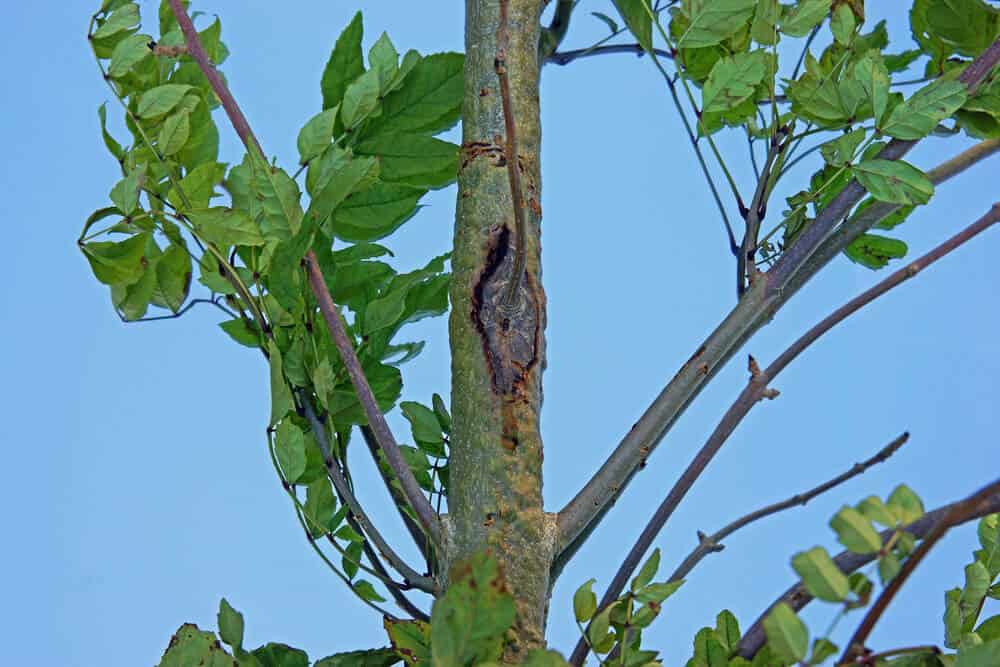What is Ash Dieback and What are the Implications
Ash Dieback FAQ Answered by Green Leaf Remediation & Tree Services
Ash dieback, also known as Hymenoscyphus Fraxineus and which used to be called Chalara Fraxinea is a fungus that originated in Asia and first came to Europe around 30 years ago. Because our native ash species did not evolve with the fungus, they do not have a natural defence against it, which has devastated the European ash (Fraxinus excelsior).
The fungus that causes ash dieback has been known in Europe for about 30 years but wasn’t officially described until 2006.
Ash dieback was first recorded in the UK in 2012. It has had the most impact in the southeast of England, although there is more and more evidence of the disease throughout the UK. There is no information on how long the fungus has grown in the area before the symptoms appeared, but it is thought to be many years. Tree experts have predicted we are still at the beginning of the Ash Dieback epidemic and as the progression of the disease is slow we won’t know the full impact of it for years.
It is predicted that Ash dieback will kill around 80% of ash trees across the UK. Ash dieback can affect ash trees of all ages but younger trees tend to succumb to the disease a lot quicker. The cost of the management and removal will be billions and the effects on our landscape will be staggering and have the potential to threaten many species which rely on the ash.
Green Leaf Remediation & Tree Services are experts in the identification and treatment of Ash Dieback as well as tree removal. If you think you could have Ash Dieback then contact us today on 01269 591651 or 07531 142316 and we can arrange for one of our tree surgeons to come out and fully assess it for you.
What happens to an ash tree with Ash Dieback?
Ash dieback causes leaf loss and crown dieback in affected trees and can lead to the death of the tree. During winter, the fungus on leaves and ash leaf stalks litter the ground. From July to October, the fungus releases spores as small white fruiting bodies and these spores can then blow miles around, further spreading the disease. The spores land on ash leaves and then penetrate into the leaf and then the fungus then grows inside the tree. When this happens, the fungus eventually blocks the tree’s water transport system, causing it to die.
An Ash tree can and often fights back against the disease, however, the fungus will keep growing and attacking it and unfortunately will eventually kill it. This is why if the ash Dieback is identified it is better to remove the tree to prevent it from spreading the disease further.
What should you do if you have Ash Dieback?
You can help to prevent the local spread of the disease by regularly collecting the fallen ash leaves with the fungus and then burning, burying or deep composting them.
What are the signs of Ash Dieback?
Ash dieback is typically characterised by dark brownish-orange leaf lesions, and patches of brown, dying leaves. A tree that has been infected with the disease loses leaves from its canopy and can develop lesions on its bark.
How do I know if my Ash has Ash Dieback?

- The shoot on saplings turn black and shrivel, and the side shoots die
- Dead, blackened leaves are visible, as well as brown veins and stalks of leaves.
- In mature trees the dieback of branches, often accompanied by bushy, epicormic growth, is noticeable.
- Black blotches or dark patches appear on the leaves in the summer, often at the leaf base and mid leaf
- Leaves will wilt and discolour
- Small lens-shaped lesions or necrotic spots appear on stems, the bark of stems as well as branches
- Leaves will be shed early
- The shoots of the tree and its will dieback visibly in the summer
- Where branches meet the trunk, lesions develop. They are usually diamond-shaped and dark brown
- Under the lesions, the inner bark appears brownish-grey
- Further down the trunk, growth has appeared from dormant buds. Epicormic growth is a common response to stress in trees
Green Leaf Remediation & Tree Services are experts in Ash Dieback and can identify it for you, as well as offer you advice on what you should do.
Are trees capable of recovering from Ash Dieback?
When more than half of a tree’s canopy is affected by ash dieback, it is highly unlikely that the tree will recover and will make it susceptible to other damaging diseases as well.
Can Ash Dieback be cured?
Unfortunately, there is no cure for ash dieback, however, some ash trees can resist full infection for some time, although 80% of ash trees do eventually die from it.
Is it necessary to remove dead Ash trees?
If an ash tree or any tree is dead then it should be removed by a Tree specialist as it could fall and or its branches break and then seriously injure someone, an animal or other trees and plants around it.
Do you have to report Ash Dieback?
You should report new cases or suspected cases of the disease to the Forestry Commission through their Tree Alert service here: https://www.forestresearch.gov.uk/tools-and-resources/fthr/tree-alert/
You should keep a close eye on the safety of the tree as the disease progresses it could fall or branches break and injure someone. You should also follow the advice of a Tree specialist like South Wales Knotweed as they will assess the safety of the tree and will know how likely it is to be spreading the disease to other ash trees within the area.
Will my Ash tree Die?
Healthy and more mature ash trees are usually the last to die but 80% will succumb to ash dieback and die within a few years. We have found some ash trees have completely survived the infestation and are still healthy in some places.
Is Ash Dieback contagious?
Ash dieback can be spread tens of miles due to the wind blowing the spores of the fungus to other trees in other areas and this is why you should always seek the advice of a tree specialist like South Wales Knotweed and Tree Services. Ash seeds, plants, or other planting materials are currently prohibited from being imported or moved inland because of this.
Why are ash trees so important?
Due to their historical resistance to pests and ability to tolerate adverse growing conditions, such as compaction and drought, ash trees play an important part in our natural landscape. By providing shade, they absorb gaseous air pollutants and help conserve energy, as well as contributing to the aesthetics of our countryside.
If you think you could have Ash Dieback then contact us today on 01269 591651 or 07531 142316 and we can arrange for one of our tree surgeons to come out and fully assess it for you.
“In the past week, we have been involved in felling a large quantity of ash dieback that were situated within the ‘danger zone’ of the main A483 public highway is Penllergaer. The work needed to be conducted within 4 weeks due to the perceived risk to members of the public.
The area had been severely overgrown with dense vegetation over a number of years, hence the tracked flail was needed in advance to create adequate space and a safe working area for our team. Roughly 15T of wood was cut to the size requested by the landowner.
The 1st phase was completed safely. On to the 2nd phase in a few weeks. ????????????”
If you are and think you’ve spotted the signs and symptoms of ash dieback you should report them through TreeAlert in Britain.
You can find the full guidance on Ash Dieback from the Forest research here.
Chalara manual – 2. Managing ash trees and woodland, including logs and firewood
1. Principles
The principles underlying the guidance presented below are:
maintaining, where possible, the values and benefits associated with ash woodlands and iconic trees;
securing an economic return where timber production is an important objective;
maintaining as much genetic diversity in ash trees as possible with the aim of ensuring the presence of ash in the long term; and
minimising impacts on associated species and wider biodiversity.
2. Management options
There is currently no cure for chalara ash dieback, and no clear method for stopping its spread. Therefore the aim of management, as outlined in the National Chalara Management Plan, should be to slow the spread, minimise the impact of the disease, and preserve as many chalara-tolerant ash trees as possible.
Before making any changes to existing management regimes, owners and managers should carefully consider their objectives and local circumstances. Any woodland or individual tree can bring a variety of benefits, and be managed for those multiple benefits. The categorisation below is made purely to assist the owner or the manager when thinking about what to do next – in practice a hybrid approach might be appropriate.
About Us
Green Leaf Remediation and Tree Services are experts in Ash Dieback and can fully advise you on the best course of action.
Our services are provided by qualified and skilled tree surgeons with extensive experience and knowledge of the industry. They all hold CSCS (Construction Skills Certification Scheme) cards and are accredited to either Lantra or City & Guilds NPTC Level 2 in chainsaw use as well as being compliant with all industry standards.
Our work conforms with the current best practices for Arboricultural works and is in accordance with BS3998 (2010). We provide assurance to all our clients that we strictly adhere to all Health & Safety legislation at all times and we have full public liability & professional indemnity insurance, in the unlikely event that it is needed.
Our experienced NPTC or LANTRA qualified chainsaw operators & tree surgeons have in excess of 40 years combined experience within the forestry industry.
Our Qualifications Include:
-
- City & Guilds NPTC Level 2
- Principles of Safe Handling & Application of Pesticides (PA1/PA6)
- Principles of Safe Handling & Application of Pesticides near water (PA6AW)
- Herbicide Stem Injection
- Property Care Association
- The Control & Eradication of Japanese Knotweed Surveyor’s Training Course
- Qualified Technician (PCAQT) in Japanese Knotweed
- Accredited Surveyor in Japanese Knotweed
- NPTC or LANTRA qualified chainsaw operators & tree surgeons
We cover South Wales (including Swansea, Cardiff and Newport), West Wales up to North Ceredigion & Powys and throughout South Glamorgan, Gwent & Tenby, Bristol, the West Country, and as far north as Shropshire and into the Midlands & Birmingham areas.
If you are looking for tree or garden services or you think you may have Ash Dieback then contact us today on 01269 591651 or 07531 142316 and we can answer any questions you may have or arrange your free site survey.

Martyn works for Green Leaf Remediation as a marketing specialist. He takes great pride in creating quality content regarding Japanese knotweed.
